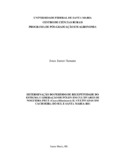| dc.creator | Hamann, Jonas Janner | |
| dc.date.accessioned | 2019-02-12T11:55:27Z | |
| dc.date.available | 2019-02-12T11:55:27Z | |
| dc.date.issued | 2018-08-06 | |
| dc.identifier.uri | http://repositorio.ufsm.br/handle/1/15608 | |
| dc.description.abstract | Pecan (Carya illinoinensis) is commercially cultivated in USA, México, Australia, South Africa, Argentina, Uruguay and Brazil. This is a species that has dichogamy, a sort of biological phenomenon where the staminate inflorescence matures in a different period than the pistillate inflorescence which naturally reduces the occurrence of self-pollinization. Dichogamy makes it necessary to plant pollinating cultivars in a commercial pecã orchard. In Brazil, the only research on the flowering period of pecã was carried out for more than three decades, but the most of these cultivars are not longer grown commercially. With the constant increase of the area cultivated with pecã the determination of the receptivity period of the stigma and release of pollen has fundamental importance for a high pollination and productivity of nuts. The pollination period of ten pecã cultivars grown commercially in RS, Brazil in the years 2016 and 2017, was determined in Cachoeira do Sul and Santa Maria. The results showed that there are differences in its flowering periods between the two years and sites. In 2017, when the temperature in September was higher in both municipalities (Cachoeira do Sul and Santa Maria), there was a anticipation in the release of pollen and receptivity of the stigma of the most cultivars, but cv. Barton maintained practically the same behavior in the orchard located in Cachoeira do Sul and Santa Maria, in both years. It can be concluded that the current recommendation of cultivar for pollinization elaborated by nurseries and the technicians related to brazilian pecã industry should be renewed for the principal cv. Barton. The cultivars Cape Fear, Chickasaw, Desirable and Success did not pollinate cv. Barton in the two years in Cachoeira do Sul and the cultivars Cape Fear and Chickasaw did not pollinate the cv. Barton in neither of the two years in Santa Maria. | eng |
| dc.description.sponsorship | Conselho Nacional de Pesquisa e Desenvolvimento Científico e Tecnológico - CNPq | por |
| dc.language | por | por |
| dc.publisher | Universidade Federal de Santa Maria | por |
| dc.rights | Attribution-NonCommercial-NoDerivatives 4.0 International | * |
| dc.rights.uri | http://creativecommons.org/licenses/by-nc-nd/4.0/ | * |
| dc.subject | Polinização | por |
| dc.subject | Pecan | por |
| dc.subject | Nozes | por |
| dc.subject | Pollination | eng |
| dc.subject | Pecan | eng |
| dc.subject | Nuts | eng |
| dc.title | Determinação do período de receptividade do estigma e liberação de pólen em cultivares de nogueira-pecã (Carya illinoinensis K.) cultivadas em Cachoeira do Sul e Santa Maria (RS) | por |
| dc.title.alternative | Determination of the stigma receptivity period and pollen release in cultivares of nogueira-pecan (Carya illinoinensis K.) cultivated in Cachoeira do Sul and Santa Maria (RS) | eng |
| dc.type | Dissertação | por |
| dc.description.resumo | A nogueira-pecã (Carya illinoinensis) é uma planta cultivada comercialmente nos EUA, México, Austrália, África do Sul, Argentina, Uruguai e Brasil. Esta é uma espécie que possui dicogamia, fenômeno biológico onde a inflorescência estaminada amadurece em período diferente da inflorescência pistilada, o que naturalmente reduz a ocorrência da autopolinização. A dicogamia torna necessário o plantio de cultivares polinizadoras em um pomar comercial de pecã. No Brasil a única pesquisa sobre o período de florescimento da nogueira-pecã foi realizado a mais de três décadas, mas em cultivares que, na sua maioria, hoje não são mais cultivadas comercialmente. Com o aumento constante da área cultivada com pecã a determinação do período de receptividade do estigma e liberação de pólen é de fundamental importância para uma alta polinização e produtividade de nozes. Foi determinado o período de polinização de dez cultivares de nogueira-pecã cultivadas comercialmente no RS, nos anos de 2016 e 2017, nos municípios de Cachoeira do Sul e Santa Maria. Os resultados mostraram que há diferença neste período do florescimento na maioria das cultivares nestes dois anos e locais. Em 2017, quando a temperatura no mês de setembro foi mais elevada em ambos os locais (Cachoeira do Sul e Santa Maria), houve antecipação na liberação de pólen e receptividade do estigma, porém a cv. Barton, principal cultivar plantada atualmente, manteve praticamente o mesmo comportamento nos pomares localizados em Cachoeira do Sul e Santa Maria, em ambos os anos. Pode-se concluir que a atual recomendação de cvs. polinizadoras elaborada por viveiristas e técnicos ligados à pecanicultura brasileira deve ser revista para a cv. principal Barton. As cultivares Cape Fear, Chickasaw, Desirable e Success não polinizaram a cv. Barton em nenhum dos dois anos em Cachoeira do Sul e as cultivares Cape Fear e Chickasaw não polinizaram a cv. Barton em nenhum dos dois anos em Santa Maria. | por |
| dc.contributor.advisor1 | Brackmann, Auri | |
| dc.contributor.advisor1Lattes | http://lattes.cnpq.br/1305840929832646 | por |
| dc.contributor.referee1 | Both, Vanderlei | |
| dc.contributor.referee1Lattes | http://lattes.cnpq.br/7025063171663786 | por |
| dc.contributor.referee2 | Saquet, Adriano Arriel | |
| dc.contributor.referee2Lattes | http://lattes.cnpq.br/3556854966790391 | por |
| dc.creator.Lattes | http://lattes.cnpq.br/6245184000767408 | por |
| dc.publisher.country | Brasil | por |
| dc.publisher.department | Agronomia | por |
| dc.publisher.initials | UFSM | por |
| dc.publisher.program | Programa de Pós-Graduação em Agronomia | por |
| dc.subject.cnpq | CNPQ::CIENCIAS AGRARIAS::AGRONOMIA | por |
| dc.publisher.unidade | Centro de Ciências Rurais | por |



